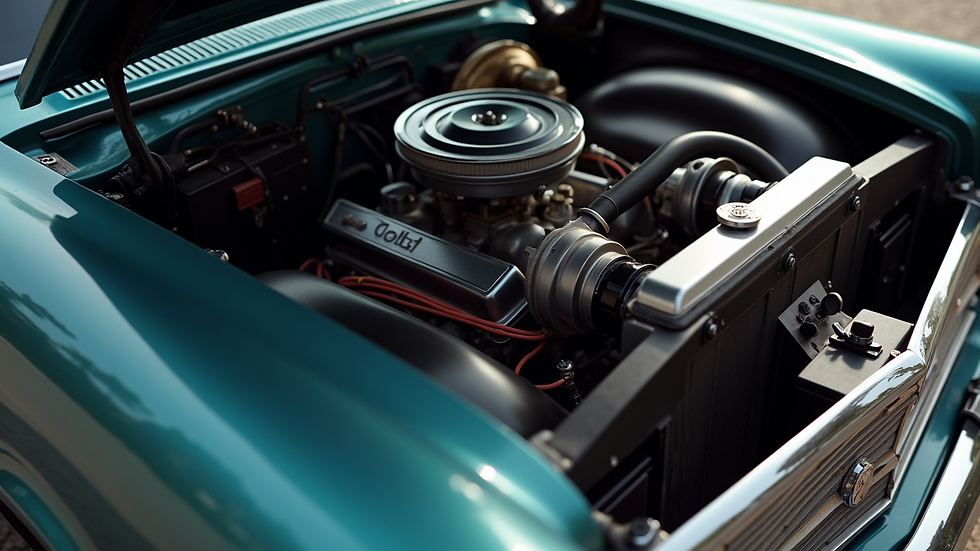Top Classic Car Restoration Parts Guide
- blueshark3d
- Sep 29
- 4 min read
Restoring a classic car is a rewarding journey filled with discovery, patience, and a deep appreciation for automotive history. Whether you’re bringing a vintage beauty back to life or maintaining a cherished ride, knowing which parts to focus on can make all the difference. In this guide, I’ll walk you through the essential components you’ll want to consider when sourcing parts for your restoration project. From the engine bay to the interior trim, I’ll share practical tips and insights to help you make smart choices and keep your classic car looking and running like new.
Understanding the Classic Car Parts Guide
When diving into a restoration, it’s important to have a clear roadmap of the parts you’ll need. Classic cars often require components that are no longer in production or are hard to find. This is where a reliable parts guide becomes invaluable. It helps you identify what’s essential, what can be refurbished, and what should be replaced outright.
Here are some key categories to focus on:
Mechanical parts: Engine components, brakes, suspension, and transmission.
Body parts: Panels, trim, bumpers, and glass.
Interior parts: Seats, dashboard, carpets, and knobs.
Electrical parts: Wiring, lights, and switches.
Knowing the condition of each area will help you prioritize your budget and time. For example, if the engine is in good shape, you might focus more on bodywork and interior restoration.

Essential Classic Car Parts Guide: What to Look For
When sourcing parts, quality and authenticity are key. Here’s a breakdown of some of the most important parts to consider:
Engine and Drivetrain Components
The heart of any classic car is its engine. Look for parts like carburettors, pistons, gaskets, and timing chains that match your car’s original specifications. Replacing worn-out engine parts with high-quality replacements can improve performance and reliability.
The transmission and differential also deserve attention. Check for leaks, worn gears, and smooth operation. Rebuilding or replacing these parts can be costly but is often necessary for a smooth driving experience.
Suspension and Brakes
Suspension parts such as shocks, springs, and bushings affect ride comfort and handling. Over time, these components wear out and should be replaced with parts designed for your specific model.
Brakes are critical for safety. Classic cars often have drum brakes, which may need new shoes, cylinders, or even a conversion to disc brakes for better stopping power. Make sure to inspect brake lines and master cylinders as well.
Body and Exterior Trim
Rust and dents are common issues with classic cars. Body panels, fenders, and bumpers might need repair or replacement. Finding original or reproduction parts that fit well can be challenging but is essential for maintaining the car’s authentic look.
Don’t forget smaller trim pieces like badges, chrome strips, and door handles. These details add character and value to your restoration.

Interior Components
The interior is where you spend most of your time, so comfort and aesthetics matter. Seats may need reupholstering or replacement foam. Dashboards often require restoration of gauges, switches, and wood or metal trim.
Carpets and headliners can be replaced with period-correct materials to keep the vintage feel. Small details like knobs, handles, and steering wheels also contribute to the overall look.
Electrical System
Classic cars have simpler electrical systems than modern vehicles, but wiring can degrade over time. Inspect the wiring harness for cracks or corrosion and replace as needed.
Lights, including headlights, tail lights, and indicators, should be checked for functionality and authenticity. Upgrading to LED bulbs is an option, but some prefer to keep the original look.
Where to Find Quality Classic Car Restoration Parts
Finding the right parts can be a challenge, but there are several reliable sources to explore:
Specialist suppliers: Companies that focus on classic car parts often have extensive catalogues and expertise.
Online marketplaces: Websites and forums dedicated to classic cars can connect you with sellers worldwide.
Car clubs and events: Networking with other enthusiasts can lead to valuable tips and parts swaps.
Salvage yards: Sometimes, you can find rare parts by visiting yards that specialise in older vehicles.
One excellent resource I recommend is Blue Shark 3D, which specialises in high-quality, precision-made plastic replacement parts. Their products are perfect for those hard-to-find components that can make or break a restoration project.

Tips for Successful Classic Car Restoration
Restoring a classic car is a marathon, not a sprint. Here are some tips to keep your project on track:
Plan thoroughly: Make a detailed list of parts needed and set a realistic budget.
Research extensively: Know your car’s history and specifications to find the right parts.
Prioritise safety: Don’t cut corners on brakes, suspension, or electrical systems.
Document your work: Take photos and notes to track progress and help with future maintenance.
Be patient: Some parts may take time to source, but quality is worth the wait.
By following these guidelines, you’ll enjoy the process and end up with a car that’s both beautiful and reliable.
Keeping Your Classic Car in Top Shape
Once your restoration is complete, maintaining your classic car is the next step. Regular inspections, cleaning, and servicing will keep it running smoothly and looking great. Store your car in a dry, covered space to prevent rust and damage.
Joining a local car club or online community can provide ongoing support and advice. Plus, it’s a great way to share your passion with like-minded enthusiasts.
Remember, every classic car has its own story, and with the right parts and care, you can keep that story alive for years to come.
I hope this guide helps you navigate the exciting world of classic car restoration parts. Whether you’re hunting for that elusive trim piece or rebuilding an engine, the right knowledge and resources make all the difference. Happy restoring!




Comments